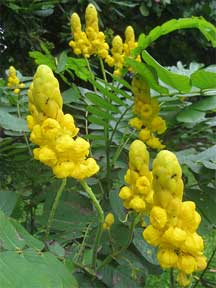Back in the 1950’s travelers to Cuba were introduced to an exotic plant flowering at Christmas time called Candlebush (Cassia alata) along with poinsettias however it took a long time for it to make its way from tropical America along the southeastern U. S. coastal states to southern US.
Candlebush has many things to recommend it for general garden use in areas with a long growing season. It will flower during early October from seeds sown outdoors during early April in the Tulsa area and two weeks earlier in Dallas. It is the one of the few annuals whose foliage shows no damage from intense July and August heat. It is decorative from seedling stage to maturity, and a passer-by stopper when in flower.

Most gardeners of the central part of the US are familiar with our native Cassia marilandica that we bring into our gardens from the wild. Unlike this fern-like plant, the candlebush is bold with alternating fronds from two to three feet long. The compound leaves made up of 12 to 28 oblong leaflets are held at an upright angle giving the plant a palm-like appearance. The flowers are stiff and are held like candles borne on the candelabra branches.
The name candle comes, perhaps, from the translucent quality of the sepals that clasp each tight little rose like bud. Alata, meaning winged, is suggested by the long winged, scallop edged seed pods.
Growing candlebush is easy. Soak the hard black seeds overnight in water, then plant them outdoors as you would morning glories during April. As plants stand still during rainy periods. if you do not care to take a chance of a rainy April and May slowing up plants it would be well to start the seeds indoors by late February in the Tulsa area.
In my test garden it was found that certain candlebush plants grew no higher than two feet by September. When plants were lifted to find out the cause it was found that the nodules made by nitrogen—fixing bacteria were not present, accounting for the poor growth made by the plant. As candlebush is a legume requiring the association of nitrogen fixing bacteria on its roots, it would be good growth insurance to dust seeds of the plant with a commercial preparation of nitrogen fixing bacteria.
Candlebush is tap rooted, which suggests early transplanting from greenhouse or seedbed outdoors or shifting to pots so that it can be transplanted without root disturbance later.
Gardeners often wonder if they can induce candlebush to flower earlier by mulching the roots so that they will winter over. In Houston, candlebush sometimes survives during mild winters. However, the winter over plants showed no gain over those raised and flowered the same year from seed.
by LE Quinlan
